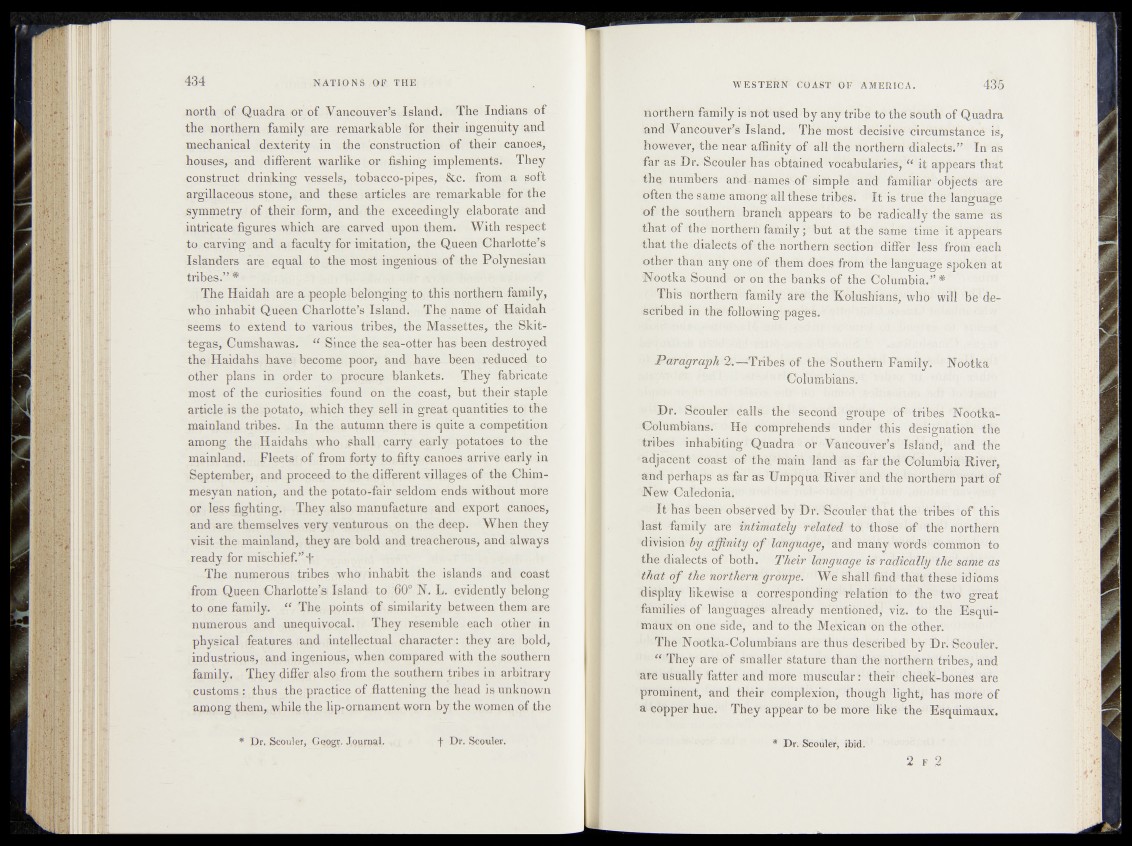
north of Quadra or of Vancouver’s Island. The Indians of
the northern family are remarkable Tor their ingenuity apd
mechanical dexterity in the construction of their canoes,
houses,, and different warlike or fishing implements. They
construct drinking vessels, tobacco-pipes, &c. from a soft
ai^ibtc^ous, stone,, and these articles are mmarkahloljfor .the
symmetry of their form, and the exceedingly elaborate and
intricate, figures which are-carved upon them. With respect
to carving and a faculty for imitation, the Queen Charlotte’s
Islanders are equal to the most ingenious of the Polynesian
tribes.” *
The Haidah are a people belonging to, this northern family,
who inhabit Queen Charlotte’s Island. The name of Haidah
seems to extend to various tribes, the MaSSettes, thetBkit-!
tegas, Cumshawas. “ Since the sea-otter has been destroyed
the Haidahs. have? become poor, and have been xedueed to
other plans in order to procure blankets. They fabricate
most of the curiosities found on the coast, but their stapl©
article is the potato, which they sell in great quantities to the
mainland tribes. In the autumn there is quite a competition
among the Haidahs who shall. carry early potatoes to the
mainland. Fleets of from forty to fifty canoes arrive early in
September, and proceed to the different villages of the Chim-
mesyan nation, and the potato-fair seldom ends without more
or less fighting. They also manufacture and export canoes,
and are themselves very venturous on the deep. When they
visit the mainland, they are bold and treacherous, and, always
ready for mischief.” T
The numerous tribes who / inhabit the islands and coast
from Queen Charlotte’s Island to 60° N. L. evidently belong
to one family. “ The points of similarity between them are
numerous and unequivocal. They resemble each other in
physical features and intellectual character: they are hold,
industrious, and ingenious, when compared with the southern
family. They differ also from the southern tribes in arbitrary
customs.: thus the practice of flattening the head is unknown
among them, while the Up*ornament worn by the women of the
Dr. Scouler, Ge^gr. Journal. ■f Dr. Scouler.
noitbfetaf family istiotvtiledffiy an f tribd'tO the south of Quadra
and Vancodver’s Island.1 The!<rtfo$t ‘decisive1 circumstance is,
however, the near affinity of alkt^e northern -dikleCts.” In as
far as Dr. SnOulerba® obtained WOd'aMlUrieS,'*“ it appears that
th^ numbers and-naftitesSof simple and familiar ofejnlcfeIa’re
often the same ambiignaJl ! I t‘is”tfue theTaii^uS'ge
of thd isonthern' branch appears,l tb hh' ^adfcal-l^"the same as
that of the northern family at th#ԤUfefe timedt a'ppedrfe
tb it the dialects-^f+the northern section differ ’ Mis -frora‘;§ach
other than any otf#^f> them ddb§ from^tie ldffginige spoken at
Wootka Sound- o r’on the banks of the^tfolambia.”
This northern family Urej the KohisbiUnS, wlib’-’vVill be!de-
scribed in the; folldwingfepag©&.> |
J^&rayraph 'Tribes'-Of thè'S'dhthern Family; u ^oèïka
W’ïCóM&Mans.5
Dr. SfeOuler calls the” S'ec'orid ’gtóupe !bf fliBëS «Nó'ófika-
■Cdumbiu«èï>' He ébmpfdhehds1 under this dësipiktioh' flife
tribes inhabiting Quadra o r' -Ya h f e b Öv ®^ # and the
adjacent cOast n f the. main land 'UsfaftW
and perhaps as far as HffipquaTïivdr add th‘e*hdrthéth'paft df
è-w Cafeöföhik;||
It haS tefen observed by Dri^éb&léf'thkt thë^érib$s'of thfe
last family are intimately related^^ töV^o iê^^’thé^Éërthefn
division by affinity o f lOftgiïdyé, ! add many wÖidS'dónnmoh to
the dialects of both. Their léncfu&ge iê^raïfflêkfflptyhe^sëkië tts
that o f the northern gröttpe. J W^fbatf Md-fKaf thdleUd iOms
display likewise a eorrtiipóh<rog! t%lhtïdö’td-s
families of languages»‘already mentioned | viz.- td'tlld Esquimaux
on one side, and to the MeXican ontheiMier;
TheIJfootka-Columbians are' thus dekèrribèd !by Dri-'SboUldr.
! “ They are of smaller stature than th&northern tribes, and
are usually fatter and more : ïhtiiëtiÉtr f 40®».' cheek-bones S#e
prominent, and their eöihpféXïon, though' lights feas'ffibïéèf
a copper hue. They appear to be more like the Esquimaux.
* Dr. Scouler, ibid.
2 F 2